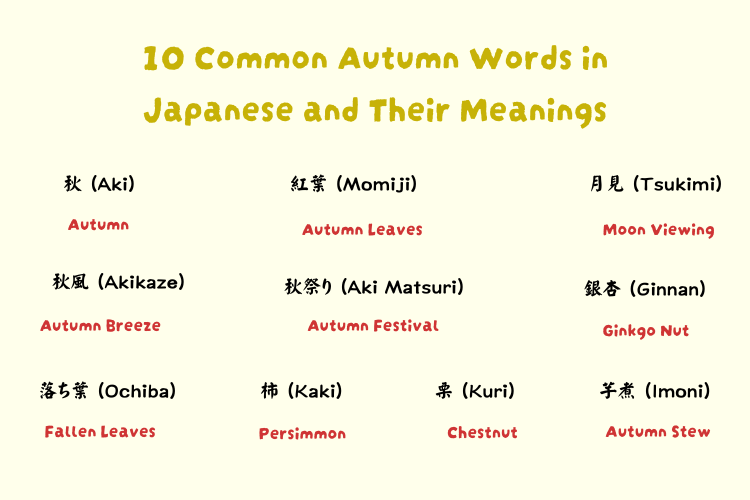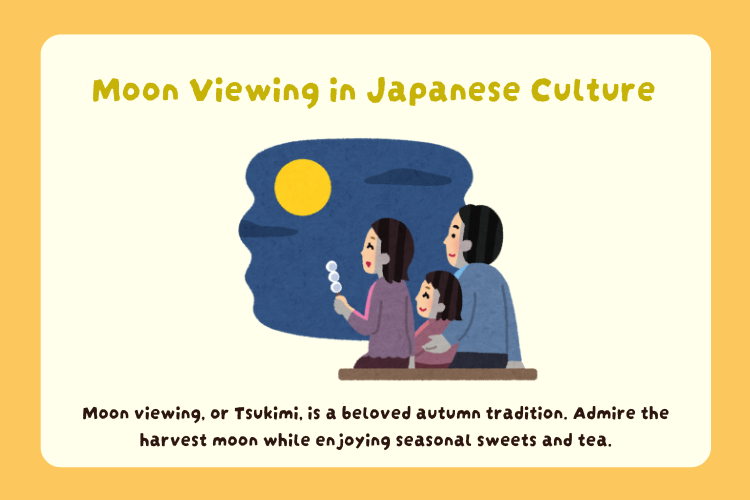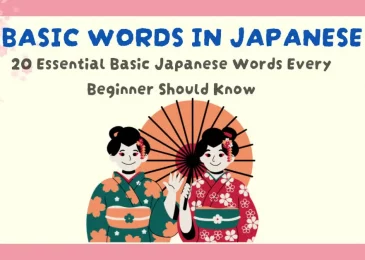- 10 Common Autumn Words in Japanese and Their Meanings
- Celebrating Autumn in Japan
- Famous Spots for Autumn Leaves (Momiji)
- Autumn Haiku and Literature
- Seasonal Activities in Japan: Must-Try Experiences in Autumn
- Autumn Idioms and Expressions
- Conclusion
- FAQs
Autumn in Japanese, or aki (秋), is a season of breathtaking beauty and cultural richness. Known for its vibrant foliage, cool breezes, and deep cultural significance, autumn is a time of gratitude, reflection, and celebration. From the red and golden hues of Momiji (autumn leaves) to the cozy traditions that bring people together, Japan’s autumn offers a perfect blend of natural beauty and cultural experiences. This guide delves into the essence of autumn in Japan, exploring its vocabulary, traditions, and unique charm.
10 Common Autumn Words in Japanese and Their Meanings
Here are 10 essential autumn-related Japanese words, with simple explanations to help you understand the beauty of the season:
- 秋 (Aki) – Autumn
The Japanese word for autumn represents the season of vibrant colors and cool breezes.
- 紅葉 (Momiji) – Autumn Leaves
Refers specifically to the red leaves of maple trees, a symbol of autumn beauty in Japan.
- 月見 (Tsukimi) – Moon Viewing
A traditional event where people admire the harvest moon in mid-autumn.
- 栗 (Kuri) – Chestnut
A popular autumn ingredient used in seasonal sweets and rice dishes.
- 銀杏 (Ginnan) – Ginkgo Nut
The edible seed of the ginkgo tree is commonly roasted and eaten in autumn.
- 秋祭り (Aki Matsuri) – Autumn Festival
Seasonal festivals that celebrate the harvest with food, dances, and parades.
- 落ち葉 (Ochiba) – Fallen Leaves
Refers to the colorful leaves that fall and create stunning autumn landscapes.
- 柿 (Kaki) – Persimmon
A sweet and juicy autumn fruit enjoyed fresh or dried.
- 秋風 (Akikaze) – Autumn Breeze
The cool, crisp wind is associated with the arrival of autumn.
- 芋煮 (Imoni) – Autumn Stew
A hearty dish made with taro, vegetables, and meat, traditionally cooked outdoors during autumn gatherings.
These words capture the essence of Japanese autumn and its cultural significance.
MochiKanji: Learn Japanese Autumn Vocabulary Efficiently
To truly appreciate autumn in Japan, mastering seasonal vocabulary is key. MochiKanji is the perfect tool to help you efficiently learn autumn-related words like Momiji and Tsukimi. Using Spaced Repetition Systems (SRS), the app ensures that you retain high-frequency seasonal terms and kanji through timely reviews.
MochiKanji also incorporates visual mnemonics and interactive quizzes to make learning kanji for autumn foods, festivals, and nature more engaging. For example, as you study the kanji for aki (秋), MochiKanji will show related words like akikaze (autumn breeze), helping you see connections and deepen your understanding.
Whether you’re preparing for a trip to Japan or simply diving into its culture from home, MochiKanji provides a structured and enjoyable way to build your autumn vocabulary. Make learning Japanese seasonal words a natural part of your autumn experience!
Celebrating Autumn in Japan
Autumn in Japan is filled with traditions and festivals that reflect the season’s beauty and abundance.
Festivals and Traditions
• Tsukimi (月見): Moon-viewing festivals are celebrated in mid-autumn. Families and friends gather to admire the full moon while enjoying seasonal delicacies like dango (sweet rice dumplings).
• Autumn Harvest Festivals: Local aki matsuri celebrate the harvest, offering gratitude to deities for a bountiful season. These festivals often feature parades, traditional performances, and food stalls.
Seasonal Foods
Autumn in Japan is a culinary delight. Seasonal foods highlight the country’s appreciation for nature’s bounty:
• Chestnuts (kuri): Used in desserts like kuri manju (sweet buns filled with chestnut paste).
• Sweet Potatoes (satsumaimo): Enjoyed roasted or in daigaku imo (candied sweet potatoes).
• Matsutake Mushrooms: A prized ingredient in soups and rice dishes.
• Persimmons (kaki): Eaten fresh or dried as a sweet snack.
These traditions and foods showcase how deeply intertwined Japanese culture is with the changing seasons
Famous Spots for Autumn Leaves (Momiji)
Autumn leaves, or Momiji, are one of Japan’s most celebrated natural spectacles. Here are some of the best locations to enjoy autumn foliage:
• Kyoto: Famous for its temples and gardens, Kyoto offers stunning views at Kiyomizu-dera and Arashiyama.
• Nikko: Known for its vibrant forests, Nikko’s Momiji transforms its shrines and lakes into a picturesque wonderland.
• Mount Takao: Just an hour from Tokyo, Mount Takao is perfect for a day trip to see colorful leaves.
Japanese people value the act of viewing nature (hanami) as a way to connect with the seasons, and autumn leaves are no exception. Many travel across the country to capture the fleeting beauty of Momiji.
Autumn Haiku and Literature
Autumn has long been a favorite subject of Japanese poets and writers. In haiku, aki serves as a kigo (seasonal word) to evoke the emotions of the season—nostalgia, transience, and beauty.
Example Haiku:
紅葉散り
秋の静けさ
旅の終わり
(Momiji chiri / Aki no shizukesa / Tabi no owari)
“Leaves fall; autumn’s stillness; the journey ends.”
Traditional literature and art capture the melancholic yet serene essence of autumn, reflecting the Japanese appreciation for nature’s impermanence.
Seasonal Activities in Japan: Must-Try Experiences in Autumn
Autumn in Japan is the perfect season to experience both the natural beauty of the changing leaves and the rich cultural traditions. Here’s a closer look at popular seasonal activities and where you can enjoy them:
Hiking and Nature Walks
Cooler weather and vibrant foliage make hiking and nature walks a favorite activity in autumn. Here are a few stunning destinations:
• Kamikochi (Nagano Prefecture): Often called the “Japanese Alps,” Kamikochi boasts breathtaking trails framed by brilliant red and gold leaves, with the serene Azusa River running through the valley.
• Mount Takao (Tokyo): A quick escape from the city, this popular hiking spot offers panoramic views and trails lined with autumn colors, peaking in November.
• Arashiyama (Kyoto): Known for its bamboo grove, Arashiyama transforms in autumn with the nearby mountains painted in fiery shades of orange and red, making it ideal for a tranquil nature walk.
Hot Springs (Onsen)
Autumn is the perfect time to enjoy onsen (hot springs), especially those surrounded by picturesque autumn leaves. Some of the best onsen experiences include:
• Hakone (Kanagawa Prefecture): Renowned for its open-air baths overlooking Mount Fuji, Hakone combines scenic beauty with relaxing hot spring baths.
• Kusatsu Onsen (Gunma Prefecture): As one of Japan’s top hot spring towns, Kusatsu offers traditional bathing experiences amidst a backdrop of autumn-hued mountains.
• Nyuto Onsen (Akita Prefecture): This rustic onsen village, tucked in the mountains, provides a peaceful, secluded atmosphere with incredible views of autumn foliage.
Autumn Festivals (Aki Matsuri)
Japanese autumn festivals are vibrant events that celebrate the harvest and seasonal beauty. Here are some highlights:
• Takayama Autumn Festival (Gifu Prefecture): This centuries-old festival features elaborate floats paraded through Takayama’s old town streets, with lights illuminating the floats at night.
• Jidai Matsuri (Kyoto): Celebrating Kyoto’s rich history, this festival showcases a grand parade with participants wearing traditional attire from different historical periods.
• Kawagoe Festival (Saitama Prefecture): Known for its lively atmosphere, this event features float competitions and traditional performances set in a charming Edo-style townscape.
Moon Viewing (Tsukimi)
Moon viewing, or tsukimi, is a beloved autumn tradition. Admire the harvest moon while enjoying seasonal sweets and tea at these iconic locations:
• Himeji Castle (Hyogo Prefecture): This UNESCO World Heritage Site offers an enchanting view of the moon alongside the illuminated castle.
• Sankeien Garden (Yokohama): A serene garden that hosts traditional moon-viewing events with performances and tea ceremonies.
Seasonal Food Experiences
Autumn is also a time for indulging in delicious seasonal foods, and these activities add a fun, interactive twist:
• Chestnut Picking: Visit orchards in Yamanashi or Nagano Prefectures to pick fresh chestnuts, a staple of autumn treats.
• Matsutake Mushroom Hunting: Tottori Prefecture offers guided tours to forage for matsutake mushrooms, prized for their rich, earthy flavor.
• Imoni Gatherings: Yamagata Prefecture hosts riverside imoni parties, where locals cook a hearty taro and beef stew—a perfect dish for crisp autumn days.
These activities make autumn in Japan a season to remember, offering opportunities to connect with nature and experience the country’s unique traditions.
Autumn in Japanese Pop Culture
Autumn plays a prominent role in Japanese anime, movies, and songs, often symbolizing change, nostalgia, or new beginnings.
• Anime and Movies: Many Japanese shows feature autumn settings to create a reflective or romantic atmosphere. Falling leaves and warm lighting add emotional depth to stories.
• Songs: Autumn-themed songs like “Koyo no Uta” (Song of Autumn Leaves) evoke feelings of nostalgia.
Pop culture often amplifies the imagery of autumn, making it one of the most visually and emotionally expressive seasons in Japan.
How to Experience Autumn Like the Japanese
If you want to immerse yourself in Japanese autumn traditions, here are some ways to do so:
• Cook Seasonal Dishes: Try making kuri gohan (chestnut rice) or roasted sweet potatoes.
• Write a Haiku: Capture your own impressions of autumn with a simple haiku.
• Create Momiji-Inspired Crafts: Fold origami maple leaves or decorate with autumn colors to bring a touch of Japanese autumn into your home.
Embracing these traditions can help you experience the season more authentically.
Autumn Idioms and Expressions
Japanese has many idioms and expressions related to autumn, reflecting its cultural significance.
• 秋の夜長 (Aki no yonaga): “Long autumn nights” refer to the season’s slower pace, ideal for reading or reflection.
• 食欲の秋 (Shokuyoku no aki): “Autumn is the season for hearty appetites,” highlighting the abundance of seasonal foods.
• 紅葉狩り (Momiji-gari): “Autumn leaf hunting,” a term for viewing autumn foliage.
Using these expressions helps you appreciate the cultural depth of autumn in Japan.
Conclusion
Autumn in Japan is a season of vibrant colors, deep cultural traditions, and a profound appreciation for nature’s beauty. From momiji-gari to moon-viewing festivals, the season offers countless ways to connect with Japanese culture. By learning the vocabulary, participating in seasonal activities, and exploring the country’s stunning landscapes, you can fully embrace the charm of Japanese autumn. Whether you’re visiting Japan or celebrating from afar, autumn is a time to reflect, savor, and celebrate life’s fleeting beauty.
FAQs
What is autumn called in Japan?
In Japanese, autumn is called 秋 (あき, aki). The season is associated with cooler weather, falling leaves, and various cultural festivals.
Does Aki mean autumn in Japanese?
Yes, Aki (秋) means autumn in Japanese. It can be used as a noun to refer to the season or as a given name that signifies the autumn season.
What is the Japanese word for autumn moon?
The Japanese word for autumn moon is 秋月 (あきづき, akizuki). This term is often used to describe the beautiful and clear moon seen during the autumn season, which is celebrated in various traditional festivals and poetry.








